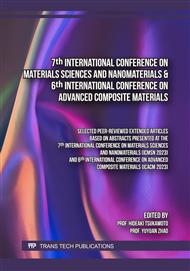[1]
R. M. D'Ambrosio et al., "Crystallization and stereocomplexation of PLA-mb-PBS multi-block copolymers," Polymers (Basel), vol. 10, no. 1, 2018.
DOI: 10.3390/polym10010008
Google Scholar
[2]
S. Y. Hwang, E. S. Yoo, and S. S. Im, "The synthesis of copolymers, blends and composites based on poly (butylene succinate)," Polymer Journal, vol. 44, no. 12. p.1179–1190, 2012.
DOI: 10.1038/pj.2012.157
Google Scholar
[3]
A. Bhatia, R. K. Gupta, S. N. Bhattacharya, and H. J. Choi, "Compatibility of biodegradable poly (lactic acid) (PLA) and poly (butylene succinate) (PBS) blends for packaging application," Korea Australia Rheology Journal, vol. 19, no. 3, p.125–131, 2007.
DOI: 10.3139/217.2214
Google Scholar
[4]
E. Hassan, Y. Wei, H. Jiao, and Y. Muhuo, "Dynamic mechanical properties and thermal stability of poly (lactic acid) and poly (butylene succinate) blends composites," Journal of Fiber Bioengineering and Informatics, vol. 6, no. 1, p.85–94, 2013.
DOI: 10.3993/jfbi03201308
Google Scholar
[5]
Fabio Seigi MURAKAMI1, P. O. RODRIGUES, C. M. T. de CAMPOS, and M. A. S. SILVA, "Physicochemical study of calcium carbonate₃ from egg shells," Ciência e Tecnologia de Alimentos, vol. 27, no. 3, p.658–662, 2007.
DOI: 10.1590/S0101-20612007000300035
Google Scholar
[6]
A. Wiriya-Amornchai, P. Nu-Yang, P. Raksawong, P. Salakkham, S. Katib, and P. Bunroek, "Effect of eggshell powder using for an extender on the mechanical and thermal behaviors of polylactic acid composites," Key Eng Mater, vol. 904 KEM, p.207–212, 2021.
DOI: 10.4028/www.scientific.net/KEM.904.207
Google Scholar
[7]
Y. Li, C. Han, Y. Yu, L. Xiao, and Y. Shao, "Isothermal and nonisothermal cold crystallization kinetics of poly(l-lactide)/functionalized eggshell powder composites," J Therm Anal Calorim, vol. 131, no. 3, p.2213–2223, 2018.
DOI: 10.1007/s10973-017-6783-5
Google Scholar
[8]
K. S. Su Shen, Kopitzky Rodion, Tolga Sengül, "Polylactide (PLA) and Its Blends with Poly (butylene," Polymers (Basel), p.1–21, 2019.
DOI: 10.3390/polym11071193
Google Scholar
[9]
R. Homklin and N. Hongsriphan, "Mechanical and thermal properties of PLA/PBS cocontinuous blends adding nucleating agent," Energy Procedia, vol. 34, p.871–879, 2013.
DOI: 10.1016/j.egypro.2013.06.824
Google Scholar
[10]
B. Nekhamanurak, P. Patanathabutr, and N. Hongsriphan, "The influence of micro-/ nano-CaCO3 on thermal stability and melt rheology behavior of poly (lactic acid)," Energy Procedia, vol. 56, p.118–128, 2014.
DOI: 10.1016/j.egypro.2014.07.139
Google Scholar
[11]
Z. Zhu, H. He, B. Xue, Z. Zhan, G. Wang, and M. Chen, "Morphology, thermal, mechanical properties and rheological behavior of biodegradable poly(butylene succinate)/poly(lactic acid) in-situ submicrofibrillar composites," Materials, vol. 11, no. 12. 2018.
DOI: 10.3390/ma11122422
Google Scholar
[12]
P. Russo, D. Acierno, and G. Filippone, Mechanical performance of polylactic based formulations, Fourteenth., no. 1932. Elsevier Ltd., 2015.
DOI: 10.1016/B978-1-78242-373-7.00002-0
Google Scholar
[13]
Z. Bartczak, A. S. Argon, R. E. Cohen, and M. Weinberg, "Toughness mechanism in semi-crystalline polymer blends: II. High-density polyethylene toughened with calcium carbonate filler particles."
DOI: 10.1016/s0032-3861(98)00444-3
Google Scholar
[14]
R. Dweiri, "Processing and characterization of surface treated chicken eggshell and calcium carbonate particles filled high-density polyethylene composites," Materials Research, vol. 24, no. 3, Mar. 2021.
DOI: 10.1590/1980-5373-MR-2021-0078
Google Scholar
[15]
L. Jompang et al., "Poly (lactic acid) and poly (butylene succinate) blend fibers prepared by melt spinning technique," Energy Procedia, vol. 34, p.493–499, 2013.
DOI: 10.1016/j.egypro.2013.06.777
Google Scholar
[16]
V. F. Sciuti, C. C. Melo, L. B. Canto, and R. B. Canto, "Influence of surface crystalline structures on DSC analysis of PTFE," Materials Research, vol. 20, no. 5, p.1350–1359, Oct. 2017.
DOI: 10.1590/1980-5373-MR-2017-0326
Google Scholar



